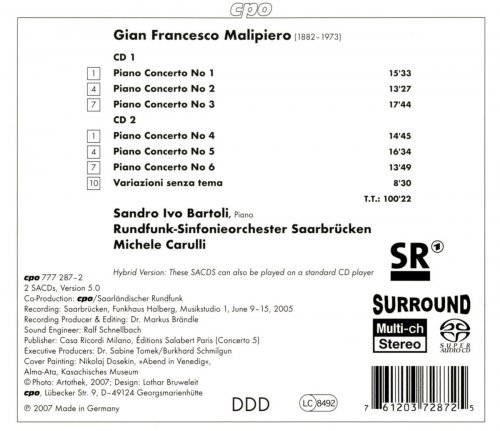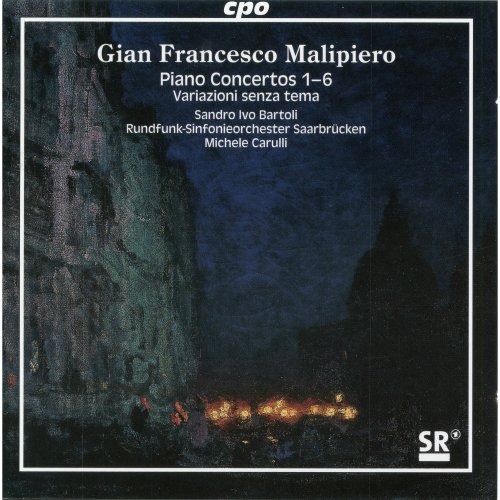
Sandro Ivo Bartoli, Rundfunk-Sinfonieorchester Saarbrücken, Michele Carulli - Malipiero: Piano Concertos Nos. 1-6 (2007)
- Title: Malipiero: Piano Concertos Nos. 1-6
- Year Of Release: 2007
- Label: CPO
- Genre: Classical
- Quality: flac lossless (tracks)
- Total Time: 01:40:23
- Total Size: 441 mb
- WebSite: Album Preview
Tracklist
CD1
01. Piano Concerto No. 1: I. Allegro moderato
02. Piano Concerto No. 1: II. Andante
03. Piano Concerto No. 1: III. Allegro
04. Piano Concerto No. 2: I. Allegro, molto marcato
05. Piano Concerto No. 2: II. Lento
06. Piano Concerto No. 2: III. Allegro
07. Piano Concerto No. 3: I. Allegro
08. Piano Concerto No. 3: II. Lento
09. Piano Concerto No. 3: III. Allegro agitato
CD2
01. Piano Concerto No. 4: I. Allegro
02. Piano Concerto No. 4: II. Lento
03. Piano Concerto No. 4: III. Allegro vivace
04. Piano Concerto No. 5: I. Allegro
05. Piano Concerto No. 5: II. Non troppo lento
06. Piano Concerto No. 5: III. Allegro
07. Piano Concerto No. 6 "Delle macchine": I. Allegro
08. Piano Concerto No. 6 "Delle macchine": II. Lento
09. Piano Concerto No. 6 "Delle macchine": III. Allegro
10. Variazioni senza tema

Some might balk at the notion of a cycle of six piano concertos by Gian Francesco Malipiero, particularly as all but two of them belong to the last 25 years of his career, a period where the number of his symphonies ballooned from four to 12, with each allegedly becoming more willful and eccentric than the previous one. Such notions, constituting the conventional wisdom about Malipiero, were advanced by certain, mostly non-Italian, scholars admittedly in a better position to know more than most others, having studied his music at some length. Nevertheless, many of these investigations were conducted in the years following Malipiero's death in 1973, an era not conducive to passing its blessing on predominantly tonal, seemingly "conservative in outlook" twentieth century music. While this conventional wisdom about Malipiero may have reigned outside Italy and his continued neglect held in accord, within Italy musicians were taking a different view of the composer. Pianist Sandro Ivo Bartoli, the featured soloist on CPO's Gian Francesco Malipiero: Piano Concertos 1-6, recalls running out to buy the score of the Third Concerto the very first time he heard Malipiero's music during a lecture; that was in 1986. Bartoli comments that the "Third Concerto crystallizes with almost photographic detail much of Malipiero's poetic aspirations," and indeed, there are passages within it that are dark and brooding in the manner of Rachmaninov's Third Concerto, and as glitteringly showy as other parts of that work. However, Malipiero's sense of harmony is strikingly different; it is nearly neo-classic in a sense, but with the edges rounded off. Malipiero's brand of "neo-classicism" is neither cold like Stravinsky's, nor tightly efficient like Prokofiev's, nor plain like Copland's; it is elegant, distinctively Italian, and specifically Venetian. The First Piano Concerto, composed in 1934, is exactly contemporary with Malipiero's First Violin Concerto, which André Gertler's 1974 recording makes clear is one of the most extraordinary violin concertos of the 1930s, worthy to stand along with the Stravinsky and the Berg. The First Piano Concerto is in the same league -- it is a moving, stunningly beautiful work, and the Second (1937) seems not that far off the same mark, at least based on a cursory listen, though Bartoli points out some of its weaknesses in his useful and well-written text. The Fourth Concerto (1950) was written for Dimitri Mitropoulos to play and conduct with the New York Philharmonic at Carnegie Hall, and its concision and tremendous transparency of texture, especially in the solo part, is deeply impressive. Dissonant and diatonic elements go together hand in hand; Malipiero has no problem throwing a steely and futuristic passage into the middle of slower, gentler material. The last two concerti, dating from 1958 and 1964, respectively, are the most dissonant and challenging in a harmonic sense, but they do not seem so much coming from the standpoint of growing eccentricity and advanced age (Malipiero was 82 in 1964) as from a blunted sense of optimism and a darkening of his general mood. Malipiero referred to serial atonality as "that Schoenbergian spirit that tortured music between 1920 and 1932" and to adopt such language as everyone else around him was doing in 1964 would not have been an option. In the final concerto, Piano Concerto No. 6, "Delle macchine," Malipiero returns to the machine-inspired Futurist aesthetics that he had abandoned at the end of the 1910s, long before the first concerto. The Variations senza tema (1923) is an early entry in his neo-classic phase that still retains some vestige of his pulsating, early futurist style; the opening measures almost sound like something Philip Glass would write. Soloist Sandro Ivo Bartoli hasn't come to this recording project unprepared; he has a thorough understanding of Malipiero's concertos and plays them all with high-spirited enthusiasm, verve, and buoyancy. This is significant, as Malipiero's development structures tend to be very loose and free, and to play his music well one needs to "go with the flow." Having a harder time with that is the Rundfunk-Sinfonieorchester Saarbrücken under Michele Carulli; it hangs in there dutifully, but is often audibly struggling to keep up with Bartoli. In concertos where the orchestral compliment is relatively thin, such as in the Second and Fourth, this is not so much of a problem as with the Fifth, which utilizes a relatively large orchestra. So, all with CPO's Gian Francesco Malipiero: Piano Concertos 1-6 is not necessarily ideal. However, it makes clear that the view of Malipiero as a composer written out in 1929 and better remembered as the man who restored Vivaldi and Monteverdi to the active repertoire is one that merely serves to deprive us of all of the wonderful music Malipiero composed in his long lifetime.
CD1
01. Piano Concerto No. 1: I. Allegro moderato
02. Piano Concerto No. 1: II. Andante
03. Piano Concerto No. 1: III. Allegro
04. Piano Concerto No. 2: I. Allegro, molto marcato
05. Piano Concerto No. 2: II. Lento
06. Piano Concerto No. 2: III. Allegro
07. Piano Concerto No. 3: I. Allegro
08. Piano Concerto No. 3: II. Lento
09. Piano Concerto No. 3: III. Allegro agitato
CD2
01. Piano Concerto No. 4: I. Allegro
02. Piano Concerto No. 4: II. Lento
03. Piano Concerto No. 4: III. Allegro vivace
04. Piano Concerto No. 5: I. Allegro
05. Piano Concerto No. 5: II. Non troppo lento
06. Piano Concerto No. 5: III. Allegro
07. Piano Concerto No. 6 "Delle macchine": I. Allegro
08. Piano Concerto No. 6 "Delle macchine": II. Lento
09. Piano Concerto No. 6 "Delle macchine": III. Allegro
10. Variazioni senza tema

Some might balk at the notion of a cycle of six piano concertos by Gian Francesco Malipiero, particularly as all but two of them belong to the last 25 years of his career, a period where the number of his symphonies ballooned from four to 12, with each allegedly becoming more willful and eccentric than the previous one. Such notions, constituting the conventional wisdom about Malipiero, were advanced by certain, mostly non-Italian, scholars admittedly in a better position to know more than most others, having studied his music at some length. Nevertheless, many of these investigations were conducted in the years following Malipiero's death in 1973, an era not conducive to passing its blessing on predominantly tonal, seemingly "conservative in outlook" twentieth century music. While this conventional wisdom about Malipiero may have reigned outside Italy and his continued neglect held in accord, within Italy musicians were taking a different view of the composer. Pianist Sandro Ivo Bartoli, the featured soloist on CPO's Gian Francesco Malipiero: Piano Concertos 1-6, recalls running out to buy the score of the Third Concerto the very first time he heard Malipiero's music during a lecture; that was in 1986. Bartoli comments that the "Third Concerto crystallizes with almost photographic detail much of Malipiero's poetic aspirations," and indeed, there are passages within it that are dark and brooding in the manner of Rachmaninov's Third Concerto, and as glitteringly showy as other parts of that work. However, Malipiero's sense of harmony is strikingly different; it is nearly neo-classic in a sense, but with the edges rounded off. Malipiero's brand of "neo-classicism" is neither cold like Stravinsky's, nor tightly efficient like Prokofiev's, nor plain like Copland's; it is elegant, distinctively Italian, and specifically Venetian. The First Piano Concerto, composed in 1934, is exactly contemporary with Malipiero's First Violin Concerto, which André Gertler's 1974 recording makes clear is one of the most extraordinary violin concertos of the 1930s, worthy to stand along with the Stravinsky and the Berg. The First Piano Concerto is in the same league -- it is a moving, stunningly beautiful work, and the Second (1937) seems not that far off the same mark, at least based on a cursory listen, though Bartoli points out some of its weaknesses in his useful and well-written text. The Fourth Concerto (1950) was written for Dimitri Mitropoulos to play and conduct with the New York Philharmonic at Carnegie Hall, and its concision and tremendous transparency of texture, especially in the solo part, is deeply impressive. Dissonant and diatonic elements go together hand in hand; Malipiero has no problem throwing a steely and futuristic passage into the middle of slower, gentler material. The last two concerti, dating from 1958 and 1964, respectively, are the most dissonant and challenging in a harmonic sense, but they do not seem so much coming from the standpoint of growing eccentricity and advanced age (Malipiero was 82 in 1964) as from a blunted sense of optimism and a darkening of his general mood. Malipiero referred to serial atonality as "that Schoenbergian spirit that tortured music between 1920 and 1932" and to adopt such language as everyone else around him was doing in 1964 would not have been an option. In the final concerto, Piano Concerto No. 6, "Delle macchine," Malipiero returns to the machine-inspired Futurist aesthetics that he had abandoned at the end of the 1910s, long before the first concerto. The Variations senza tema (1923) is an early entry in his neo-classic phase that still retains some vestige of his pulsating, early futurist style; the opening measures almost sound like something Philip Glass would write. Soloist Sandro Ivo Bartoli hasn't come to this recording project unprepared; he has a thorough understanding of Malipiero's concertos and plays them all with high-spirited enthusiasm, verve, and buoyancy. This is significant, as Malipiero's development structures tend to be very loose and free, and to play his music well one needs to "go with the flow." Having a harder time with that is the Rundfunk-Sinfonieorchester Saarbrücken under Michele Carulli; it hangs in there dutifully, but is often audibly struggling to keep up with Bartoli. In concertos where the orchestral compliment is relatively thin, such as in the Second and Fourth, this is not so much of a problem as with the Fifth, which utilizes a relatively large orchestra. So, all with CPO's Gian Francesco Malipiero: Piano Concertos 1-6 is not necessarily ideal. However, it makes clear that the view of Malipiero as a composer written out in 1929 and better remembered as the man who restored Vivaldi and Monteverdi to the active repertoire is one that merely serves to deprive us of all of the wonderful music Malipiero composed in his long lifetime.
As a ISRA.CLOUD's PREMIUM member you will have the following benefits:
- Unlimited high speed downloads
- Download directly without waiting time
- Unlimited parallel downloads
- Support for download accelerators
- No advertising
- Resume broken downloads


